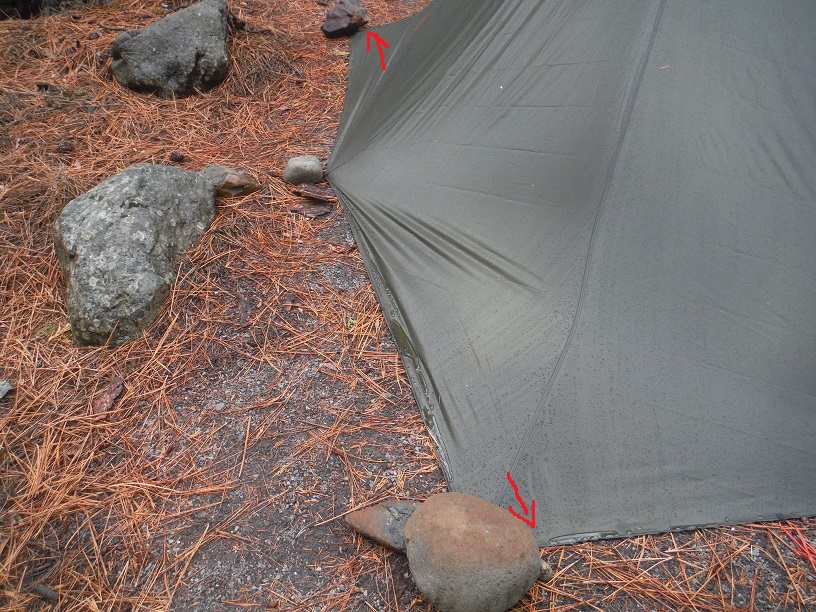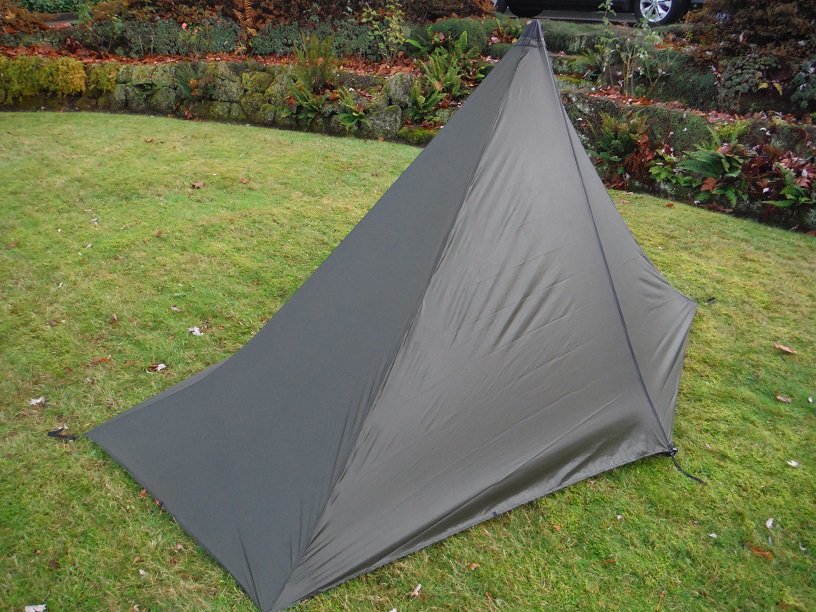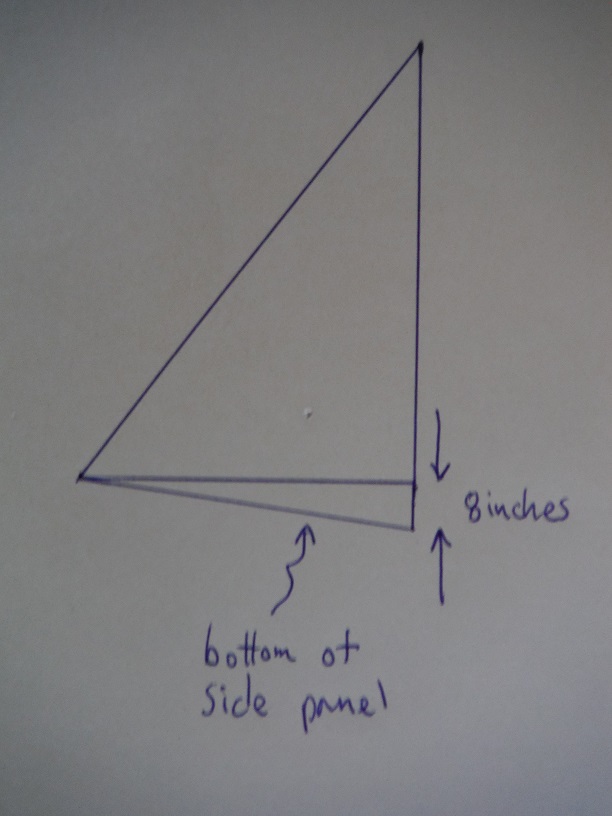Topic
tent on bias
Forum Posting
A Membership is required to post in the forums. Login or become a member to post in the member forums!
Home › Forums › Gear Forums › Make Your Own Gear › tent on bias
- This topic has 33 replies, 7 voices, and was last updated 4 years, 7 months ago by
 Jerry Adams.
Jerry Adams.
-
AuthorPosts
-
Nov 24, 2017 at 5:11 pm #3503850
One other thing, the edge of the tent actually flaps flat on the ground for a couple inches. You can see the puddle of water:

Where the tent stakes are, the edge of the tent is very close to right at ground level. The edge of the tent is on the bias. As a consequence, it has this flap.
You can see I added a grosgrain loop on the right and put a loop of thin nylon cord through it. I could use a stake to hold this and put a rock on top, that overlaps the edge of the tent by that flap distance, and then maybe stuff wouldn’t blow under the tent edge as has happened occasionally to me in the past.
Or, maybe that flap is undesirable and it would be better to have a catenary curve with about 2 inches deflection. Then it would pitch tight rather than with a flap. Again, catenary curves are required when an edge is along the bias. I think I’ll just ignore this though and use plan A – keeping stuff from blowing into the tent.
Nov 24, 2017 at 5:17 pm #3503857That RSBTR silpoly fabric is really good. I set the tent up tight, and then it stayed tight over night even when it got cold and rainy. With silnylon, I’ll wake up in the morning and the edges of the tent will droop down and it’s hard not to brush against them and get wet from condensation.
I’ve use 1.5 oz/yd2 silnylon before and found this 1 oz/yd2 silpoly seems plenty strong enough. And about the same amount difficult to sew because it’s thin and slippery.
I lay out the edges of each piece with Sharpie Proven Permanent. Then I do about 5 hand stitches on each edge – sewing through the line on each piece. Then sew with the machine along the lines, keeping both pieces aligned sideways (needle should go through line on both pieces) and aligned lengthwise using the hand stitches – it’s easy to have one piece slip relative to the other.
Nov 24, 2017 at 5:28 pm #3503862It rained a couple nights and stayed dry inside. I didn’t seal my seams.
Nov 24, 2017 at 8:50 pm #3503894The knowledge that cat cuts are required along the bias but not along other edges is really useful, and fits with my experience – although I never thought of it that way. Seems like a great rule of thumb for tent planning.
Nov 24, 2017 at 11:55 pm #3503924Thanks for sharing your project Jerry, Looking at this picture I wonder if lowering the post a little would allow you to stretch the bottom a bit more (i.e get corners further apart) and avoid that “flap” in the middle.
 Nov 25, 2017 at 2:44 am #3503957
Nov 25, 2017 at 2:44 am #3503957I’ll have to try that
I just figured the fabric would stretch so I needed a taller pole.
Nov 29, 2017 at 5:18 pm #3504650I put 6 cm (2.5 inch) catenary curve using Roger’s spreadsheet that I modified http://www.backpackinglight.com/backpackinglight/images/jerryscatenary.xls. I probably could have done 7.5 cm (3 inches). I could also do a 1.5 cm (1/2 inch) catenary curve on the center of the side. That would make it pitch a little more tight.


Weight – 13.5 ounces. 10 ounces for fabric and 3.5 ounces for everything else including 1 gallon zipper top bag. If I had made a rectangular pyramid it would have weighed another 3.5 ounces.
I use a 0.433 inch Easton pole, 61.5 inches. 3 sections. 4.5 ounces. 0.433 is pretty small, maybe 0.65 would be better – 7.5 ounces. Stakes are 3.5 ounces.
Nov 29, 2017 at 5:52 pm #3504662I’m not sure whether tent on bias is better. It has that weird bend on the ridges.
It does result in all edges being on the ground, but you could accomplish that with tent laid out normally with an octagon shape as mentioned previously. Or, lay out the side panels with the middle of each panel 8 inches longer:

With bias layout the sides have this flap against the ground as mentioned previously. I tried a shorter pole as suggested but it made no difference. If you look at the photo at the beginning of the thread of one side panel stretched out, you can see the two edges that go on the bias have large wrinkles which is what makes the edge flat.
Maybe this is a good thing. Occasionally it gets very windy and stuff blows in under the edge of the tent. If I put a grosgrain loop with nylon line in the center, and use that to pull out the tent and put a rock on top, I think that will prevent stuff blowing under.
After using a shorter pole, it occurs to me that the edge stretches out. It was designed to be 114 inches long but it stretched to 120 inches. But the ridge length is about the same as designed. If I was doing a rectangular pyramid the center pole would have to be about 3 inches shorter to make up for this. So, I should add 3 inches to the actual pole length and use that to calculate dimensions of panels of fabric.
For the half pyramid with beak it doesn’t matter that much because of the geometry – you can just move in the two corners next to the beak – complicated to explain with words, easier to figure out when you’re doing it. But next time I’ll add the 3 inches.
When you set up the half pyramid with beak, first stake the two corners that are on the opposite side from the beak, then put in the pole, then stake out the beak. This is like a three legged stool – the site doesn’t have to be flat. And the bottom of the pole doesn’t have to be on the same plane as those three stakes – easier to understand if you’re actually doing it.
Then, stake the other two corners. These don’t have to be on the same plane either. Tighten all the tent stake loops. Put in the center stake at the rear. The tent will pitch tighter if all the stakes and pole are on the same plane.
After using a square mid, and this half mid + beak, the latter requires less area of ground, and is more tolerant of a non flat site. And it saves 3.5 ounces.
Sep 9, 2019 at 5:41 pm #3609550I did a tent normal – not on the bias, and I think this works better
You can lay out the panels in a way to eliminate the gap at the edge of the tent
see https://backpackinglight.com/forums/topic/36355/page/2/#post-3609447
-
AuthorPosts
- You must be logged in to reply to this topic.
Forum Posting
A Membership is required to post in the forums. Login or become a member to post in the member forums!
Our Community Posts are Moderated
Backpacking Light community posts are moderated and here to foster helpful and positive discussions about lightweight backpacking. Please be mindful of our values and boundaries and review our Community Guidelines prior to posting.
Get the Newsletter
Gear Research & Discovery Tools
- Browse our curated Gear Shop
- See the latest Gear Deals and Sales
- Our Recommendations
- Search for Gear on Sale with the Gear Finder
- Used Gear Swap
- Member Gear Reviews and BPL Gear Review Articles
- Browse by Gear Type or Brand.







